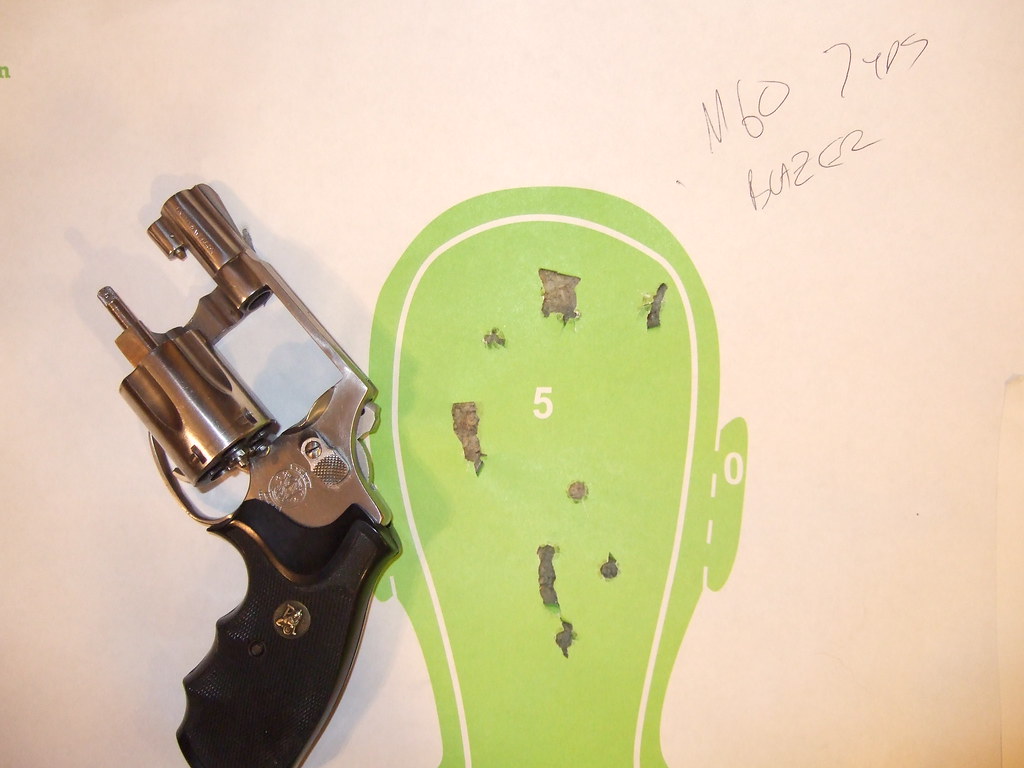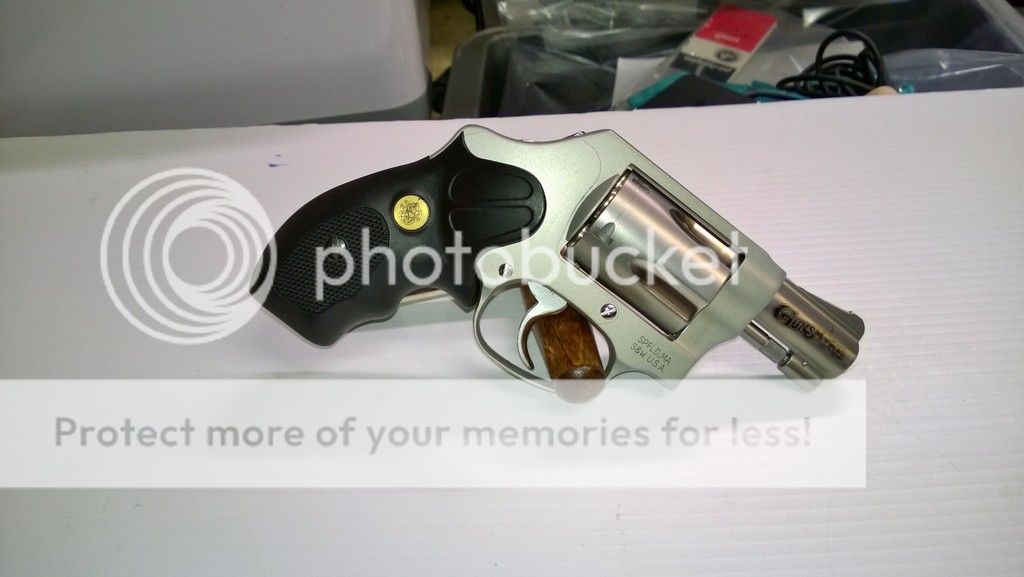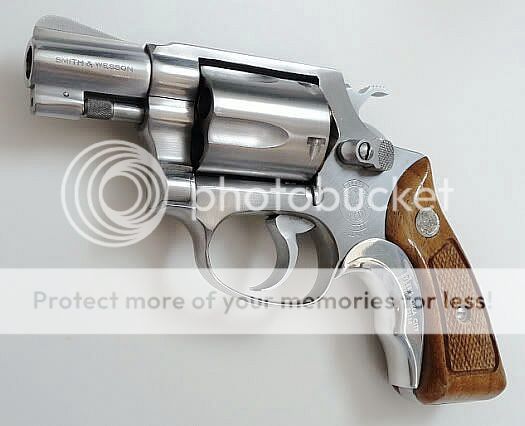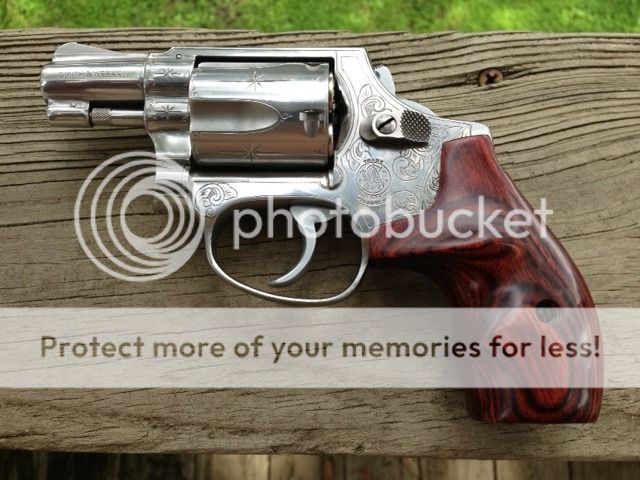I am looking at a Smith model 60 (1965 date of manufacture) with a bobbed hammer. May want to go back to a standard hammer but not sure about availability or cost. Any help would be greatly appreciated. Thanks in advance for your consideration regarding this question.
You are using an out of date browser. It may not display this or other websites correctly.
You should upgrade or use an alternative browser.
You should upgrade or use an alternative browser.
Model 60 Bobbed Hammer
- Thread starter JamesFR
- Start date
- Status
-
Not open for further replies.
texagun
Member
I would check with S&W and see if they would replace the hammer. I have no experience with bobbed hammers on S&W 60's but my long time gunsmith advises against them because reducing hammer mass can result in ignition failures. I would not want a J-frame with a bobbed hammer. If you don't want the hammer, look for a S&W Model 49. It has an enclosed hammer that won't snag on clothing.
And WELCOME to the forum. Lots of good guys with a lot of knowledge here.
And WELCOME to the forum. Lots of good guys with a lot of knowledge here.
Did you search Brownells or Midway?
I've posted on this many times - all else equal, reducing the mass of the hammer (to a point) speeds it up and enhances reliability.
It definitely helps if the gun's in spec, though - parts that aren't centered, plumb, true and smooth can start to show themselves to be a problem with a bobbed hammer, so it's best if the bobbing is part of a good action job by a knowledgeable 'smith.
I have no experience with bobbed hammers on S&W 60's but my long time gunsmith advises against them because reducing hammer mass can result in ignition failures.
I've posted on this many times - all else equal, reducing the mass of the hammer (to a point) speeds it up and enhances reliability.
It definitely helps if the gun's in spec, though - parts that aren't centered, plumb, true and smooth can start to show themselves to be a problem with a bobbed hammer, so it's best if the bobbing is part of a good action job by a knowledgeable 'smith.
texagun
Member
...all else equal, reducing the mass of the hammer (to a point) speeds it up and enhances reliability.
I understand the physical principle that says if a 5 lb. rock and a 10 lb. rock are dropped off a building at the same time, they will both hit the ground at the same time. But the 5 lb. rock won't have the force that the 10 lb. rock has because it has less mass (F=ma). If you reduce the mass, you reduce the force. So are you saying if I grind off 90% of the trigger, it will still have the same force of impact as a normal unbobbed hammer and have no effect on ignition? And how does reducing the mass of the hammer speed it up?
But the 5 lb. rock won't have the force that the 10 lb. rock has because it has less mass (F=ma). If you reduce the mass, you reduce the force.
Your rock analogy doesn't work here, because "Force" isn't variable. The spring provides the force & energy - the hammer merely transfers it. With "all else equal", the same spring is compressed the same amount, so the force applied to the hammer is the same. Because "m" decreases, "a" increases. A faster hammer hits with more "power", and power plays a big role in lighting off primers.
I also mentioned one can enhance reliability by bobbing to a point. Decreasing hammer mass increases power, but decreases momentum, and it's momentum that overcomes internal friction. At some point, the velocity of the hammer will plateau, and further decreases in mass will decrease power, leading to a rapid fall-off in reliability.
Sistema1927
Member
If the original question was about availability of J-frame hammers if the bobbed one doesn't work out, then the answer is yes, they are easily sourced. However, you might like that bobbed hammer and won't need to worry about replacing it.
Twiki357
Member
If you don’t like the bobbed hammer, you may be able to swap it with someone who does want a bobbed hammer and is considering castrating his existing gun.
I have always just found an extra hammer and bobbed it - that way you can have the best of both set ups. If I only had one hammer to work with I would leave it un-bobbed. But all of my carry snubs (all two of them) are set up with bobbed hammers because they will be used in DA only and the gun is much less resistant to snag on clothing and other things. The only revolvers I thumb cock any more are single action Rugers.
rklessdriver
Member
Occasionally used J Frame hammers pop up on Gun Broker and ebay.
Will
Will
Looks like Numrich carries hammer assemblies. The DA sear may need some fitting, which, if you don't know what you're doing, is best done by a good 'smith.
http://www.gunpartscorp.com/Products/298500.htm
http://www.gunpartscorp.com/Products/298500.htm
Speedo66
Member
I bobbed the hammer on my service carry Mdl. 36, basically the same gun. It allowed for a snag free draw from under a suit jacket, and also stopped the shredding of the inside of my suit linings.
You can still carefully fire single action if you wish. I also fitted a smooth trigger because the original ribbed one was tearing up my finger at re-qualification.
You can still carefully fire single action if you wish. I also fitted a smooth trigger because the original ribbed one was tearing up my finger at re-qualification.
Rick McC.
Member
F-111 John
Member
I inherited a Model 60 from my father when he passed, and it had a bobbed hammer. By the looks of it, it was done by a gunsmith, not a factory bob. In several hundred rounds I've never had a single issue.


RealGun
Member
This Wyatt Deep Cover 637 has a bobbed hammer direct from S&W. I don't find it listed in their current catalog on line. At least they are likely to help and have the parts, noting that the hammer on this gun came highly polished. I like it because a shrouded hammer makes a gun look pretty odd in my eyes.


Confederate
Member
Bobbed Model 60s work fine, but I wouldn't have one...just a matter of preference. Being able so shoot single action means too much, even though you can cock most of the guns with bobbed hammers by pulling the trigger slightly, catching the tip of the hammer and pulling it back.
I like the Model 60 but would have preferred a 3-inch barrel.


The Rossi M88 (bottom) has a 3-inch
barrel and in many ways is a better gun,
in my opinion.
I like the Model 60 but would have preferred a 3-inch barrel.


The Rossi M88 (bottom) has a 3-inch
barrel and in many ways is a better gun,
in my opinion.
straightshooterjake
Member
- Joined
- Sep 7, 2016
- Messages
- 239
I like hammerless J-frame revolvers, so I am used to not having an option for single action. Having a qualified gunsmith do a double action trigger job can significantly improve the shootability of the double action trigger. Due to the geometry and spring configuration, the J-frame double action cannot be made really great like a K-frame. But a double action only J-frame with a good trigger can still do everything I expect a snubnose revolver to do.
If you do have trigger work done on a revolver, it is important to work with a qualified gunsmith who will improve the trigger pull without compromising reliability. Some competition revolvers are tuned with very light springs that are only reliable with certain primers. But most stock revolvers can be significantly improved without making any compromise to reliability.
I would recommend shooting the double action only revolver a bit before making any changes. Then you could decide whether to have the double action improved or whether to add a hammer with single action capability.
If you do have trigger work done on a revolver, it is important to work with a qualified gunsmith who will improve the trigger pull without compromising reliability. Some competition revolvers are tuned with very light springs that are only reliable with certain primers. But most stock revolvers can be significantly improved without making any compromise to reliability.
I would recommend shooting the double action only revolver a bit before making any changes. Then you could decide whether to have the double action improved or whether to add a hammer with single action capability.
RealGun
Member
My gunsmith did a clean, lube, and action job on my Rossi 88 snub and commented that internally it was identical to an S&W. I have a Smith 36-1 that looks exactly like your 3" Rossi 88. Actually I think the early Rossi (Interarms) was all about cloning at import prices.Bobbed Model 60s work fine, but I wouldn't have one...just a matter of preference. Being able so shoot single action means too much, even though you can cock most of the guns with bobbed hammers by pulling the trigger slightly, catching the tip of the hammer and pulling it back.
I like the Model 60 but would have preferred a 3-inch barrel.
The Rossi M88 (bottom) has a 3-inch
barrel and in many ways is a better gun,
in my opinion.
Confederate
Member
That may be. The only difference I can tell is that the ejector rod isn't of the same workmanship as the S&W. The action is similar and the sights are actually better. I've never had any problems with Rossi. But I've had many with Taurus revolvers.Actually I think the early Rossi (Interarms) was all about cloning at import prices.

- Status
-
Not open for further replies.
Similar threads
- Replies
- 21
- Views
- 6K
- Replies
- 21
- Views
- 2K
- Locked
- Replies
- 21
- Views
- 2K
- Replies
- 8
- Views
- 1K



